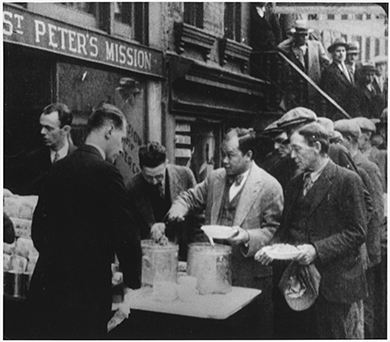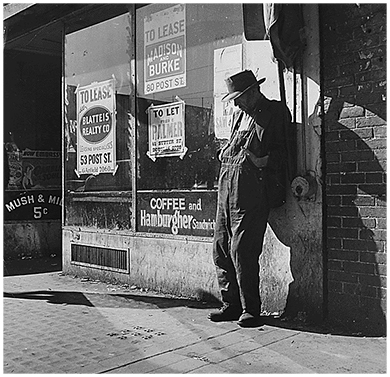| << Chapter < Page | Chapter >> Page > |

Unable to receive aid from the government, Americans thus turned to private charities; churches, synagogues, and other religious organizations; and state aid. But these organizations were not prepared to deal with the scope of the problem. Private aid organizations showed declining assets as well during the Depression, with fewer Americans possessing the ability to donate to such charities. Likewise, state governments were particularly ill-equipped. Governor Franklin D. Roosevelt was the first to institute a Department of Welfare in New York in 1929. City governments had equally little to offer. In New York City in 1932, family allowances were $2.39 per week, and only one-half of the families who qualified actually received them. In Detroit, allowances fell to fifteen cents a day per person, and eventually ran out completely. In most cases, relief was only in the form of food and fuel; organizations provided nothing in the way of rent, shelter, medical care, clothing, or other necessities. There was no infrastructure to support the elderly, who were the most vulnerable, and this population largely depended on their adult children to support them, adding to families’ burdens ( [link] ).

During this time, local community groups, such as police and teachers, worked to help the neediest. New York City police, for example, began contributing 1 percent of their salaries to start a food fund that was geared to help those found starving on the streets. In 1932, New York City schoolteachers also joined forces to try to help; they contributed as much as $250,000 per month from their own salaries to help needy children. Chicago teachers did the same, feeding some eleven thousand students out of their own pockets in 1931, despite the fact that many of them had not been paid a salary in months. These noble efforts, however, failed to fully address the level of desperation that the American public was facing.
The prosperous decade leading up to the stock market crash of 1929, with easy access to credit and a culture that encouraged speculation and risk-taking, put into place the conditions for the country’s fall. The stock market, which had been growing for years, began to decline in the summer and early fall of 1929, precipitating a panic that led to a massive stock sell-off in late October. In one month, the market lost close to 40 percent of its value. Although only a small percentage of Americans had invested in the stock market, the crash affected everyone. Banks lost millions and, in response, foreclosed on business and personal loans, which in turn pressured customers to pay back their loans, whether or not they had the cash. As the pressure mounted on individuals, the effects of the crash continued to spread. The state of the international economy, the inequitable income distribution in the United States, and, perhaps most importantly, the contagion effect of panic all played roles in the continued downward spiral of the economy.
In the immediate aftermath of the crash, the government was confident that the economy would rebound. But several factors led it to worsen instead. One significant issue was the integral role of automobiles and construction in American industry. With the crash, there was no money for either auto purchases or major construction projects; these industries therefore suffered, laying off workers, cutting wages, and reducing benefits. Affluent Americans considered the deserving poor—those who lost their money due to no fault of their own—to be especially in need of help. But at the outset of the Great Depression, there were few social safety nets in place to provide them with the necessary relief. While some families retained their wealth and middle-class lifestyle, many more were plunged quite suddenly into poverty and often homelessness. Children dropped out of school, mothers and wives went into domestic service, and the fabric of American society changed inexorably.

Notification Switch
Would you like to follow the 'U.s. history' conversation and receive update notifications?